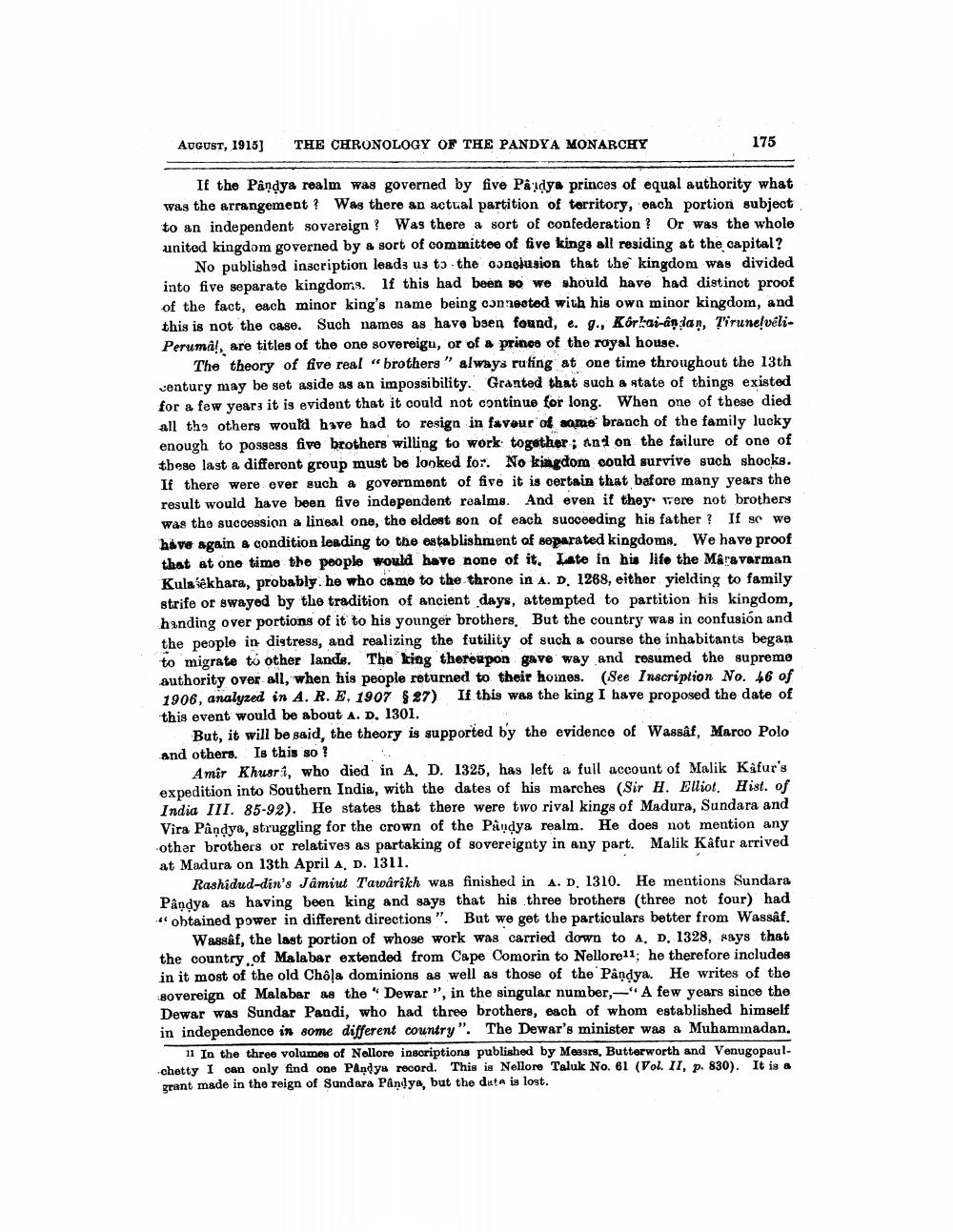________________
August, 1918)
THE CHRONOLOGY OF THE PANDYA MONARCHY
175
If the Pandya realm was governed by five Pâidya princes of equal authority what was the arrangement ? Was there an actual partition of territory, each portion subject to an independent sovereign? Was there a sort of confederation? Or was the whole united kingdom governed by a sort of committee of five kings all residing at the capital?
No published inscription leads us to the conslusion that the kingdom was divided into five separate kingdoms. If this had been so we should have had distinct proof of the fact, each minor king's name being connected with his own minor kingdom, and this is not the case. Such names as have been found, e. g., Kórkaian dan, l'irunelveliPeruma!, are titles of the one sovereigu, or of a prince of the royal house.
The theory of five real "brothers ” always ruting at one time throughout the 13th century may be set aside as an impossibility. Granted that such a state of things existed for a few years it is evident that it could not continue for long. When one of these died all the others would have had to resign in favour of name branch of the family lucky enough to possess five brothers willing to work together; and on the failure of one of these last a different group must be looked for. No kingdom could survive such shocks. If there were ever such a government of five it is oertain that bafore many years the result would have been five independent realms. And even if they were not brothers was the succession a lineal one, the eldest son of each succeeding his father? If se we háve again a condition leading to the establishment of separated kingdoms. We have proof that at one time the people would have none of it, Late in his life the Maravarman Kulasekhara, probably he who came to the throne in A. D. 1268, either yielding to family strife or swayed by the tradition of ancient days, attempted to partition his kingdom, handing over portions of it to his younger brothers. But the country was in confusion and the people in distress, and realizing the futility of such a course the inhabitants began to migrate to other lande. The king thereupon gave way and resumed the supreme authority over all, when his people returned to their homes. (See Inscription No. 46 of 1906, analyzed in A. R. E, 1907 $27) If this was the king I have proposed the date of this event would be about A. D. 1301.
But, it will be said, the theory is supported by the evidence of Wassâf, Marco Polo and others. Is this so?
Amir Khusr 1, who died in A. D. 1325, has left a full account of Malik Kafur's expedition into Southern India, with the dates of his marches (Sir H. Elliot. Hist. of India III. 85-92). He states that there were two rival kings of Madura, Sundara and Vira Pandya, struggling for the crown of the Pandya realm. He does not mention any other brothers or relatives as partaking of sovereignty in any part. Malik Kâfur arrived at Madura on 13th April A. D. 1311.
Rashidud-din's Jamiut Tawarikh was finished in A. D. 1310. He mentions Sundara Pandya as having been king and says that his three brothers (three not four) had "ohtained power in different directions". But we get the particulars better from Wassåf.
Wassâf, the last portion of whose work was carried down to A. D. 1328, says that the country of Malabar extended from Cape Comorin to Nellorell; he therefore includes in it most of the old Chôļa dominions as well as those of the Pândya. He writes of the sovereign of Malabar as the 'Dewar", in the singular number,—"A few years since the Dewar was Sundar Pandi, who had three brothers, each of whom established himself in independence in some different country". The Dewar's minister was a Muhammadan.
11 In the three volumes of Nellore inscriptions published by Messrs, Butterworth and Venugopaulchetty I can only find one Pandya record. This is Nellore Taluk No. 61 (Vol. II, p. 830). It is a grant made in the reign of Sundara Pandya, but the data is lost.




